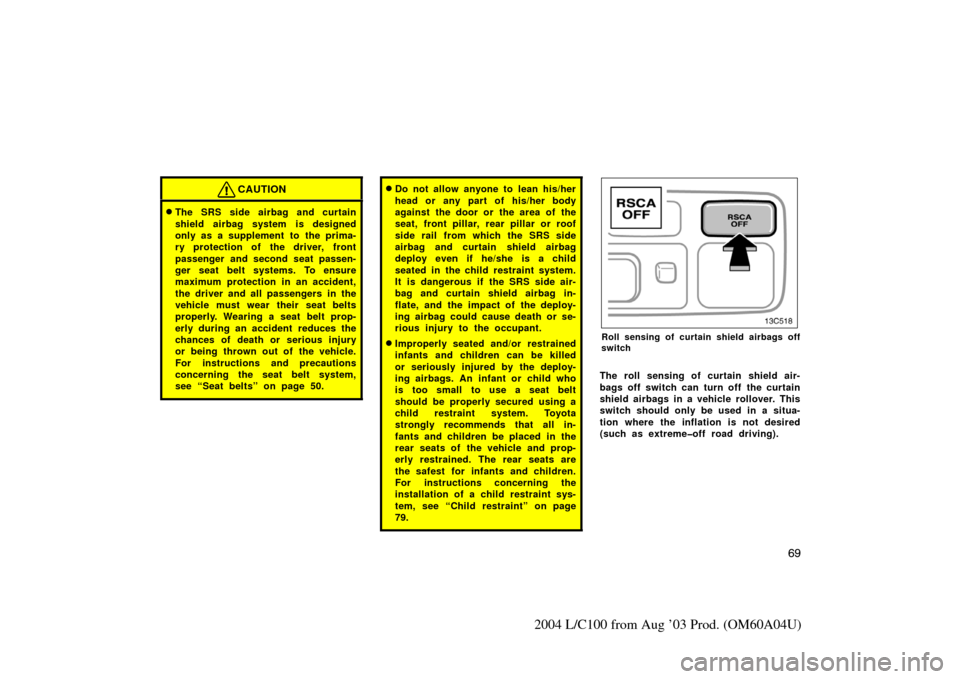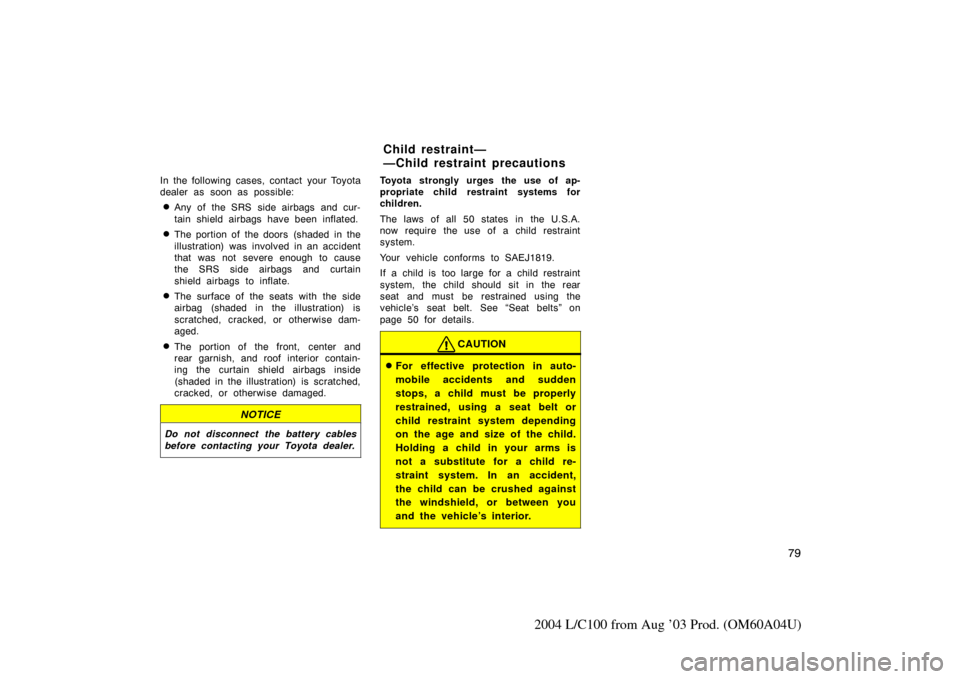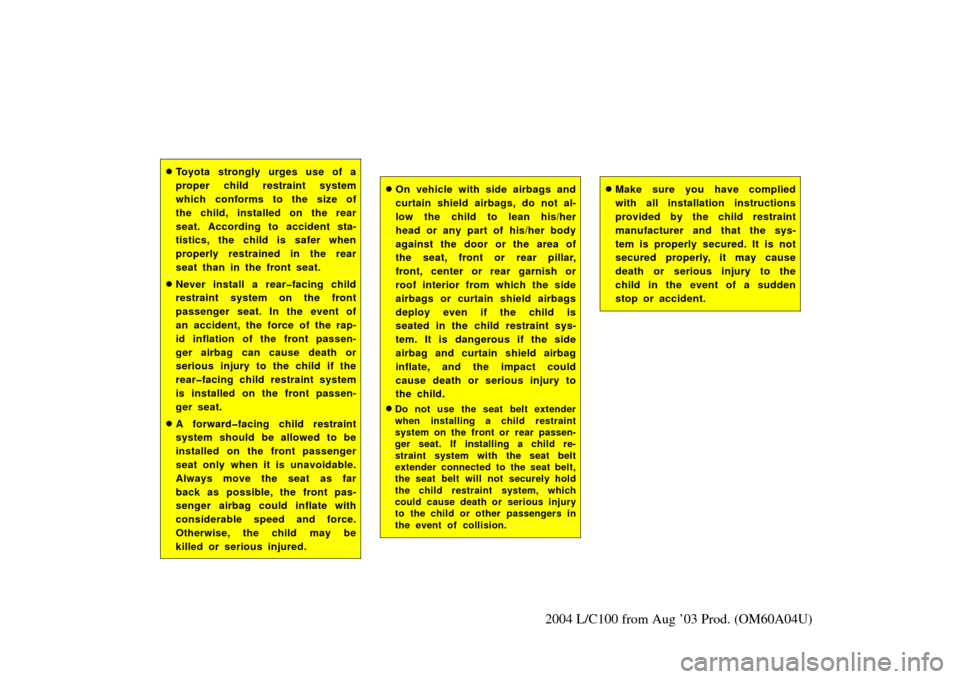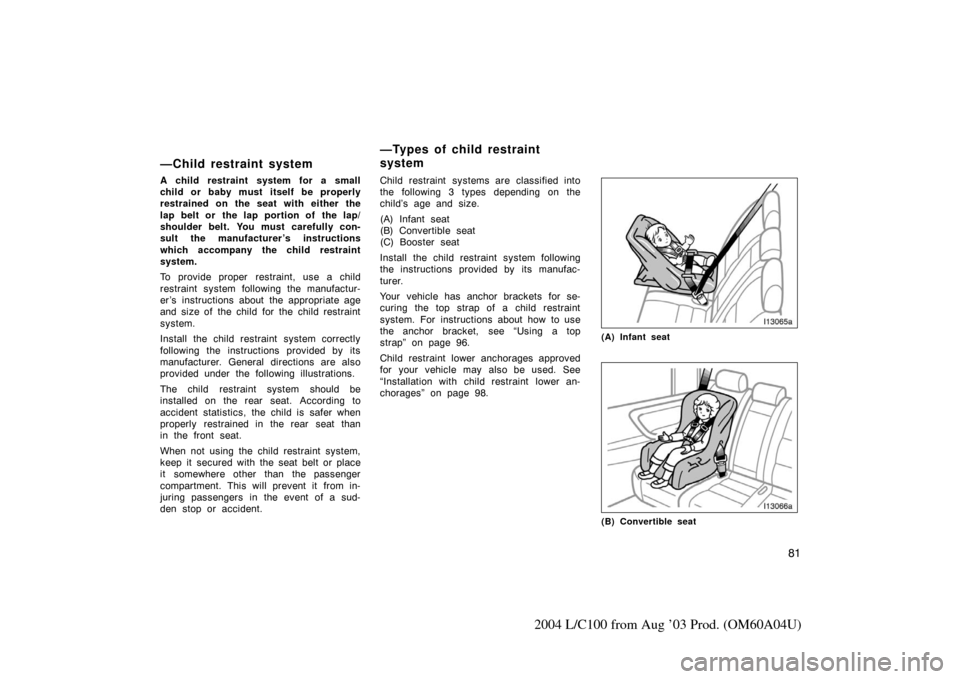Page 74 of 342

66
2004 L/C100 from Aug ’03 Prod. (OM60A04U)
�Do not hold a child on your lap
or in your arms. Use a child re-
straint system in the rear seat.
For instructions concerning the
installation of a child restraint
system, see “Child restraint” on
page 79.
�Do not put anything or any part
of your body on or in front of
the dashboard or steering wheel
pad that houses the front airbag
system. They might restrict infla-
tion or cause death or serious
injury as they are projected rear-
ward by the force of deploying
airbags. Likewise, the driver and
front passenger should not hold
objects in their arms or on their
knees.
�Do not modify or remove any
wiring. Do not modify, remove,
strike or open any components
such as the steering wheel pad,
steering wheel, column cover,
dashboard near the front passen-
ger airbag, front passenger air-
bag or airbag sensor assembly.
Doing so may prevent the front
airbag system from activating
correctly, cause sudden activa-
tion of the system or disable the
system, resulting in death or se-
rious injury.
Failure to follow these instructions
can result in death or serious injury.
Consult your Toyota dealer about any
repair and modification.
Page 77 of 342

69
2004 L/C100 from Aug ’03 Prod. (OM60A04U)
CAUTION
�The SRS side airbag and curtain
shield airbag system is designed
only as a supplement to the prima-
ry protection of the driver, front
passenger and second seat passen-
ger seat belt systems. To ensure
maximum protection in an accident,
the driver and all passengers in the
vehicle must wear their seat belts
properly. Wearing a seat belt prop-
erly during an accident reduces the
chances of death or serious injury
or being thrown out of the vehicle.
For instructions and precautions
concerning the seat belt system,
see “Seat belts” on page 50.
�Do not allow anyone to lean his/her
head or any part of his/her body
against the door or the area of the
seat, front pillar, rear pillar or roof
side rail from which the SRS side
airbag and curtain shield airbag
deploy even if he/she is a child
seated in the child restraint system.
It is dangerous if the SRS side air-
bag and curtain shield airbag in-
flate, and the impact of the deploy-
ing airbag could cause death or se-
rious injury to the occupant.
�Improperly seated and/or restrained
infants and children can be killed
or seriously injured by the deploy-
ing airbags. An infant or child who
is too small to use a seat belt
should be properly secured using a
child restraint system. Toyota
strongly recommends that all in-
fants and children be placed in the
rear seats of the vehicle and prop-
erly restrained. The rear seats are
the safest for infants and children.
For instructions concerning the
installation of a child restraint sys-
tem, see “Child restraint” on page
79.Roll sensing of curtain shield airbags off
switch
The roll sensing of curtain shield air-
bags off switch can turn off the curtain
shield airbags in a vehicle rollover. This
switch should only be used in a situa-
tion where the inflation is not desired
(such as extreme�off road driving).
Page 87 of 342

79
2004 L/C100 from Aug ’03 Prod. (OM60A04U)
In the following cases, contact your Toyota
dealer as soon as possible:
�Any of the SRS side airbags and cur-
tain shield airbags have been inflated.
�The portion of the doors (shaded in the
illustration) was involved in an accident
that was not severe enough to cause
the SRS side airbags and curtain
shield airbags to inflate.
�The surface of the seats with the side
airbag (shaded in the illustration) is
scratched, cracked, or otherwise dam-
aged.
�The portion of the front, center and
rear garnish, and roof interior contain-
ing the curtain shield airbags inside
(shaded in the illustration) is scratched,
cracked, or otherwise damaged.
NOTICE
Do not disconnect the battery cables
before contacting your Toyota dealer.
Toyota strongly urges the use of ap-
propriate child restraint systems for
children.
The laws of all 50 states in the U.S.A.
now require the use of a child restraint
system.
Your vehicle conforms to SAEJ1819.
If a child is too large for a child restraint
system, the child s hould sit in the rear
seat and must be restrained using the
vehicle’s seat belt. See “Seat belts” on
page 50 for details.
CAUTION
�For effective protection in auto-
mobile accidents and sudden
stops, a child must be properly
restrained, using a seat belt or
child restraint system depending
on the age and size of the child.
Holding a child in your arms is
not a substitute for a child re-
straint system. In an accident,
the child can be crushed against
the windshield, or between you
and the vehicle’s interior.
Child restraint—
—Child restraint precautions
Page 88 of 342

80
2004 L/C100 from Aug ’03 Prod. (OM60A04U)
�Toyota strongly urges use of a
proper child restraint system
which conforms to the size of
the child, installed on the rear
seat. According to accident sta-
tistics, the child is safer when
properly restrained in the rear
seat than in the front seat.
�Never install a rear�facing child
restraint system on the front
passenger seat. In the event of
an accident, the force of the rap-
id inflation of the front passen-
ger airbag can cause death or
serious injury to the child if the
rear�facing child restraint system
is installed on the front passen-
ger seat.
�A forward�facing child restraint
system should be allowed to be
installed on the front passenger
seat only when it is unavoidable.
Always move the seat as far
back as possible, the front pas-
senger airbag could inflate with
considerable speed and force.
Otherwise, the child may be
killed or serious injured.
�On vehicle with side airbags and
curtain shield airbags, do not al-
low the child to lean his/her
head or any part of his/her body
against the door or the area of
the seat, front or rear pillar,
front, center or rear garnish or
roof interior from which the side
airbags or curtain shield airbags
deploy even if the child is
seated in the child restraint sys-
tem. It is dangerous if the side
airbag and curtain shield airbag
inflate, and the impact could
cause death or serious injury to
the child.
�Do not use the seat belt extender
when installing a child restraint
system on the front or rear passen-
ger seat. If installing a child re-
straint system with the seat belt
extender connected to the seat belt,
the seat belt will not securely hold
the child restraint system, which
could cause death or serious injury
to the child or other passengers in
the event of collision.
�Make sure you have complied
with all installation instructions
provided by the child restraint
manufacturer and that the sys-
tem is properly secured. It is not
secured properly, it may cause
death or serious injury to the
child in the event of a sudden
stop or accident.
Page 89 of 342

81
2004 L/C100 from Aug ’03 Prod. (OM60A04U)
—Child restraint system
A child restraint system for a small
child or baby must itself be properly
restrained on the seat with either the
lap belt or the lap portion of the lap/
shoulder belt. You must carefully con-
sult the manufacturer ’s instructions
which accompany the child restraint
system.
To provide proper restraint, use a child
restraint system following the manufactur-
er ’s instructions about the appropriate age
and size of the child for the child restraint
system.
Install the child restraint system correctly
following the instructions provided by its
manufacturer. General directions are also
provided under the following illustrations.
The child restraint system should be
installed on the rear seat. According to
accident statistics, the child is safer when
properly restrained in the rear seat than
in the front seat.
When not using the child restraint system,
keep it secured with the seat belt or place
it somewhere other than the passenger
compartment. This will prevent it from in-
juring passengers in the event of a sud-
den stop or accident.Child restraint systems are classified into
the following 3 types depending on the
child’s age and size.
(A) Infant seat
(B) Convertible seat
(C) Booster seat
Install the child restraint system following
the instructions provided by its manufac-
turer.
Your vehicle has anchor brackets for se-
curing the top strap of a child restraint
system. For instructions a
bout how to use
the anchor bracket, see “Using a top
strap” on page 96.
Child restraint lower anchorages approved
for your vehicle may also be used. See
“Installation with child restraint lower an-
chorages” on page 98.
(A) Infant seat
(B) Convertible seat
—Types of child restraint
system
Page 90 of 342
82
2004 L/C100 from Aug ’03 Prod. (OM60A04U)
(C) Booster seat(A) INFANT SEAT INSTALLATION
An infant seat must be used in rear�
facing position only.CAUTION
Do not install a child restraint system
on the third seat if it interferes with
the lock mechanism of the second
seats. Otherwise, the child or second
seat occupant(s) may be killed or se-
riously injured in case of sudden
braking or a collision.
—Installation with 2�point
type seat belt
Page 91 of 342
83
2004 L/C100 from Aug ’03 Prod. (OM60A04U)
1. Run the center lap belt through oraround the infant seat following the
instructions provided by its manufactur-
er and insert the tab into the buckle
taking care not to twist the lap belt.
CAUTION
�After inserting the tab, make
sure the tab and buckle are
locked and that the lap portion
of the belt is not twisted.
�Do not insert coins, clips, etc. in
the buckle as this may prevent
your child from properly latching
the tab and buckle.
�If the seat belt does not function
normally, it cannot protect your
child from death or serious
injury. Contact your Toyota
dealer immediately. Do not install
the child restraint seat on the
seat until the seat belt is fixed.
2. While pressing the infant seat firmlyagainst the seat cushion and seatback,
tighten the lap belt by pulling its free
end to hold the infant seat securely.
Page 92 of 342
84
2004 L/C100 from Aug ’03 Prod. (OM60A04U)
CAUTION
Push and pull the child restraint sys-
tem in different directions to be sure
it is secure. Follow all the installation
instruction provided by its manufac-
turer.
3. To remove the infant seat, press thebuckle release button.(B) CONVERTIBLE SEAT INSTALLATION
A convertible seat must be used in for-
ward�facing or rear�facing position de-
pending on the age and size of the
child. When installing, follow the
manufacturer ’s instruction about the ap-
plicable age and size of the child as
well as directions for installing the
child restraint system.